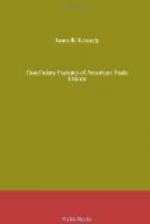[Footnote 110: Constitution, 1880 (Maplewood, 1880), p. 18.]
The younger unions have usually adopted the later revised definition of the term “permanent or total disability,” with such modifications as are made necessary by the peculiar nature of the trade. The system of the Brotherhood of Carpenters and Joiners, adopted in 1886, and still in force, defines permanent disability as “total blindness, the loss of an arm or leg, or both, the total disability of a limb, the loss of four fingers on one hand, or being afflicted with any physical disability resulting from sudden accident."[111] The Amalgamated Glass Workers as late as 1900 had made no attempt to give definite limits to the term “total disability,” but in 1903 they adopted the definition of the Carpenters and extended it to include disability resulting from paralysis.[112] The Amalgamated Wood Workers, however, still provide simply that to receive the benefit members shall be disabled from following the trade.[113]
[Footnote 111: Constitution, 1886 (n.p., n.d.), p. 11; Constitution, 1905 (Milwaukee, n.d.), p. 19.]
[Footnote 112: Constitution, 1900 (Chicago, n.d.), p. 23; Constitution, 1903, p. 11.]
[Footnote 113: Constitution of the Amalgamated Wood-Workers’ International Union of America, 1905 (Chicago, n.d.), p. 42.]
The definitions adopted by the unions are intended as guides for and restrictions upon the administrative officials, but in all cases the latter are given considerable latitude. The cost of the benefit, therefore, depends largely upon the strictness with which the officials construe the rules. In those unions where the injuries entitling to a benefit are not specifically defined, the officers have great discretionary power. Indeed, even if they have the best intention, it is in many trades often impossible to obtain positive evidence as to the totality or permanency of the disability. For example, the Brotherhood of Painters find it almost impossible to pass intelligently upon claims for disability resulting from lead poisoning.
The table on page 63 shows the sums paid for death and disability claims in certain unions for which statistics are procurable.
The addition of a disability benefit to the death benefit as appears from the table does not add greatly to the cost of maintaining the benefit. In general, the amount paid for disability ranges from five to ten per cent. of the total paid for both benefits. The cost of the benefits is somewhat increased also by the loss of dues from the time of the disability to the death of the insured.
Sums paid for
death and disability benefits.
============================================================
=========
| |Sum of Benefits Paid. |Percentage
of Benefits
| | |
Paid.
| |----------------------------------------------




